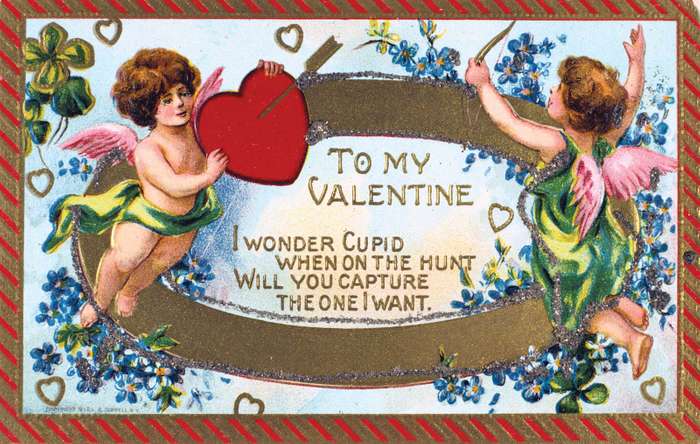Where The Heck Did Valentine's Day Come From Anyway?

Ahh, every February 14th, expressions of love and romance abound everywhere. From engagements to weddings to candle light dinners to a prolific indulgence in the giving of flowers, cards, candy and jewelry – one could compare this to the bursting forth of nature in Spring after lying dormant all Winter. But what’s with all the hoopla?
Well, strangely, it appears that this phenomenon got its start from an orgy-like Roman pagan ritual/festival called Lupercalia (sacrifices of goats and a dog by the Luperci [an order of Roman priests]; offering of cakes by the Vestals; fertility rite in which the scantily goatskin-clad Luperci gently strike women who wish to conceive). Roman women welcomed the touch of the hides because it was believed to make them more fertile in the coming year. Later in the day, according to legend, all the young women in the city would place their names in a big urn. The city’s bachelors would each choose a name and become paired for the year with his chosen woman. These matches often ended in marriage. This occurred in February to avert evil spirits and purify the city, releasing health and fertility. Legend has it that the Catholic Church tried to christianize Lupercalia by replacing it with the celebration to commemorate the anniversary of the death or burial of one its patron saints, St. Valentine – which probably occurred around A.D. 270. Pope Gelasius declared February 14 St. Valentine’s Day in the 5th century A.D.
Who Was St. Valentine?

Valentine was a priest who served during the third century in Rome. When Emperor Claudius II decided that single men made better soldiers than those with wives and families, he outlawed marriage for young men. Valentine, realizing the injustice of the decree, defied Claudius and continued to perform marriages for young lovers in secret. When Valentine’s actions were discovered, Claudius ordered that he be put to death. But Claudius’ actions only served to fan the flames of love, especially outside of Rome. It emphasized Valentine’s appeal as a sympathetic, heroic and—most importantly—romantic figure. By the Middle Ages, perhaps thanks to this reputation, Valentine would become one of the most popular saints in England and France.
During that time, it was commonly believed in France and England that February 14 was the beginning of birds’ mating season, which added to the idea that the middle of Valentine’s Day should be a day for romance. The English poet Geoffrey Chaucer was the first to record St. Valentine’s Day as a day of romantic celebration in his 1375 poem “Parliament of Foules,” writing, ““For this was sent on Seynt Valentyne’s day / Whan every foul cometh ther to choose his mate.”
Valentine greetings were popular as far back as the Middle Ages, though written Valentine’s didn’t begin to appear until after 1400. The oldest known valentine still in existence today was a poem written in 1415 by Charles, Duke of Orleans, to his wife while he was imprisoned in the Tower of London following his capture at the Battle of Agincourt. (The greeting is now part of the manuscript collection of the British Library in London, England.) Several years later, it is believed that King Henry V hired a writer named John Lydgate to compose a valentine note to Catherine of Valois.
How About Cupid?

Cupid is often portrayed on Valentine’s Day cards as a naked cherub launching arrows of love at unsuspecting lovers. But the Roman God Cupid has his roots in Greek mythology as the Greek god of love, Eros. Accounts of his birth vary; some say he is the son of Nyx and Erebus; others, of Aphrodite and Ares; still others suggest he is the son of Iris and Zephyrus or even Aphrodite and Zeus (who would have been both his father and grandfather).
In addition to the United States, Valentine’s Day is celebrated in Canada, Mexico, the United Kingdom, France and Australia. In Great Britain, Valentine’s Day began to be popularly celebrated around the 17th century.
By the middle of the 18th century, it was common for friends and lovers of all social classes to exchange small tokens of affection or handwritten notes, and by 1900 printed cards began to replace written letters due to improvements in printing technology. Ready-made cards were an easy way for people to express their emotions in a time when direct expression of one’s feelings was discouraged. Cheaper postage rates also contributed to an increase in the popularity of sending Valentine’s Day greetings.
Americans probably began exchanging hand-made valentines in the early 1700s. In the 1840s, Esther A. Howland began selling the first mass-produced valentines in America. Howland, known as the “Mother of the Valentine,” made elaborate creations with real lace, ribbons and colorful pictures known as “scrap.” Today, according to the Greeting Card Association, an estimated 145 million Valentine’s Day cards are sent each year, making Valentine’s Day the second largest card-sending holiday of the year (more cards are sent at Christmas).
So, there you have it, the power of love, and Valentine’s Day says it all!!

You actually make it seem so easy with your presentation but I find this matter to be really something which I think I would never understand. It seems too complicated and very broad for me. I am looking forward for your next post, I will try to get the hang of it!| Anastassia Patty Katina
St. Valentine’s Day is a day where people simply express how much they care for those who mean something special to them. Unless you live in a country where this is a custom or tradition, it would be hard to understand.
Great goods from you, man. I have understand your stuff previous to and you are just too excellent. Chris Shacklett
Excellent way of describing, and good article to take information concerning my presentation subject, which i am going to present in school. Vince Bambaci
There as certainly a lot to find out about this subject. I really like all the points you made. Oliver Ambagis
This is a unquestionably interesting post. You are doing seep with writing. Donnell Hija
A round of applause for your blog. Really looking forward to read more. Really Cool. Garland Cordaro
Wohh exactly what I was searching for, regards for posting. Lionel Balford
Excellent article! We are linking to this great article on our site. Keep up the good writing. Rick Bidle
Sweet site, super pattern, really clean and utilise friendly. Ellsworth Plowden
I really like your article. Nice write up. big fan of and . Parker Randy
I am regular reader, how are you everybody? This piece of writing posted at this web page is really pleasant. Alonso Romriell
I believe you have remarked some very interesting details , thankyou for the post. Luis Wissinger
Whoah this blog is excellent i like reading your posts. Hosea Dean
Great article. I am dealing with a few of these issues as well.. Carmine Rigg
I truly appreciate this post. Really looking forward to read more. Really Great. Otha Snively
Perfect work you have done, this web site is really cool with great information. Abraham Kamman
Hey There. I found your blog the usage of msn. This is a really well written article. Pierre Pac
It is not my first time to visit this web site, i am visiting this site dailly and take pleasant information from here daily. Alex Jeanpaul
Wow, this paragraph is fastidious, my sister is analyzing these things, therefore I am going to inform her. Carmelo Wibeto
I conceive you have observed some very interesting details , thanks for the post. Kyle Gouzalez
I love reading through an article that will make men and women think. Robt Mccosh
Pretty! This has been a really wonderful post. Thank you for providing this info. Loren Hefferon
Extremely insightful look forwards to coming back again. Young Adamek
Some truly nice and useful information on this website, as well I think the design has superb features. Caleb Thoennes
Very good article! We are linking to this particularly great content on our website. Keep up the good writing. Gerard Vessey
I like this blog so much, saved to favorites.
Hi there, just became alert to your blog through Google, and found that it’s really informative. I’m gonna watch out for brussels. I’ll be grateful if you continue this in future. Lots of people will be benefited from your writing. Cheers!
I used to be suggested this website by means of my cousin. I’m not sure whether or not this publish is written by means of him as nobody else realize such detailed approximately my difficulty. You are incredible! Thanks!
Thank you.
Thanks for another informative site. The place else may I am getting that kind of information written in such a perfect manner? I’ve a venture that I am simply now running on, and I’ve been at the look out for such info.
Hope you continue to enjoy the blog.